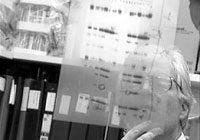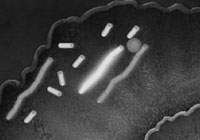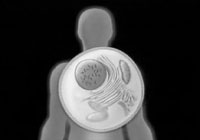 |
| ■4世紀にヨーロッパを襲った黒死病に関する記録は多くの史料に残されている |
 Recent research reveals that the bubonic plague and AIDS have a peculiar link. Recent research reveals that the bubonic plague and AIDS have a peculiar link.
 Known as the Black Death, the bubonic plague ravaged Europe in the 14th century. Its gruesome symptoms included swollen lymph nodes, high fever and delirium. The death rate was 90 percent for those exposed, and death could occur within one week after catching the bacterium. Known as the Black Death, the bubonic plague ravaged Europe in the 14th century. Its gruesome symptoms included swollen lymph nodes, high fever and delirium. The death rate was 90 percent for those exposed, and death could occur within one week after catching the bacterium.
 |
| ■処理しきれない遺体が山積みとなり、公衆衛生の問題を引き起こしたほどだった |
 "And some towns were actually so overcome with the piled bodies of the corpses that they would have them lying out in the street, and...and they would catapult them over across rivers, and they just really...it got...became a huge public health problem. It was something that...that there was an awful lot of...of...of writing about the horror that it inflicted on the people." (Dr. Stephen J. O'Brien, Chief, Laboratory of Genomic Diversity, National Cancer Institute) "And some towns were actually so overcome with the piled bodies of the corpses that they would have them lying out in the street, and...and they would catapult them over across rivers, and they just really...it got...became a huge public health problem. It was something that...that there was an awful lot of...of...of writing about the horror that it inflicted on the people." (Dr. Stephen J. O'Brien, Chief, Laboratory of Genomic Diversity, National Cancer Institute)
 Surprisingly, survivors of the bubonic plague might have bequeathed to their descendants the ability to resist infection from a dreaded disease of today: AIDS. One of the most exciting discoveries in AIDS research has been the discovery of a rare innocuous mutation that can make individuals immune to the AIDS virus. Surprisingly, survivors of the bubonic plague might have bequeathed to their descendants the ability to resist infection from a dreaded disease of today: AIDS. One of the most exciting discoveries in AIDS research has been the discovery of a rare innocuous mutation that can make individuals immune to the AIDS virus.
 |
| ■腺ペストを生き延びた人々の遺伝子が現代を生きる子孫にも伝わっている |
|
 |
| ■発見された突然変異は、このエイズ・ウイルスに対する免疫をもたらす |
|
 |
| ■CCR5変異はエイズ・ウイルスの白血球ヘの侵入を防ぐ |
 Named CCR5, this mutation has been a scientific mystery since it is only found in Caucasians of Western European descent, and since its exclusive function is to prevent the AIDS virus from invading white blood cells. Named CCR5, this mutation has been a scientific mystery since it is only found in Caucasians of Western European descent, and since its exclusive function is to prevent the AIDS virus from invading white blood cells.
 "...that the CCR5 coreceptor which causes resistance to HIV is located on a group of immune system cells called macrophages. And those are the cells which HIV en...enters initially and sets up its housekeeping. "...that the CCR5 coreceptor which causes resistance to HIV is located on a group of immune system cells called macrophages. And those are the cells which HIV en...enters initially and sets up its housekeeping.
 It doesn't kill those cells, but it replicates furiously, producing a billion copies a day in the infected patients for up to 10 years before a disease actually starts to be...to appear. It doesn't kill those cells, but it replicates furiously, producing a billion copies a day in the infected patients for up to 10 years before a disease actually starts to be...to appear.
 |
| ■CCR5変異の現れる頻度には北から南にかけてクラインがみられる、と語るオブライエン博士 |
 This is a map of...of Europe where the frequency of the CCR5 mutation is then tested in a group of some 5,000 individuals. And the important point to make is that there is a gene frequency gradient called the cline, which goes from North to South. This is a map of...of Europe where the frequency of the CCR5 mutation is then tested in a group of some 5,000 individuals. And the important point to make is that there is a gene frequency gradient called the cline, which goes from North to South.
 The highest frequency of the mutation is up in Northern Europe, Sweden, Scotland, and was up around 15 percent, and then it's around 10 percent or so in France and Germany, down around 5 percent or so in Italy and Greece, and 0 percent in Saudi Arabia and sub-Saharan Africa." (Dr. Stephen J. O'Brien) The highest frequency of the mutation is up in Northern Europe, Sweden, Scotland, and was up around 15 percent, and then it's around 10 percent or so in France and Germany, down around 5 percent or so in Italy and Greece, and 0 percent in Saudi Arabia and sub-Saharan Africa." (Dr. Stephen J. O'Brien)
 |
| ■CCR5変異の調査結果を示すヨーロッパの地図 |
|
 |
| ■CCR5変異出現率が最も高いスウェーデンとスコットランド |
|
 |
| ■オブライエン博士はCCR5変異の発生時期を特定する研究を進めた |
 Dr. Stephen O'Brien is one of the foremost AIDS researchers in the world, and he's been studying the CCR5 mutation. Dr. O'Brien speculated that the gene could not be a new mutation. Dr. Stephen O'Brien is one of the foremost AIDS researchers in the world, and he's been studying the CCR5 mutation. Dr. O'Brien speculated that the gene could not be a new mutation.
 Although AIDS is a relatively new disease, the mutation is found in a significant part of the population. This means the CCR5 mutation must've already existed before the AIDS epidemic began. Although AIDS is a relatively new disease, the mutation is found in a significant part of the population. This means the CCR5 mutation must've already existed before the AIDS epidemic began.
 To prove this, Dr. O'Brien and his colleagues dated the CCR5 mutation. They discovered that it first appeared about 700 years ago, about the time when a major epidemic of the bubonic plague was occurring in Europe. To prove this, Dr. O'Brien and his colleagues dated the CCR5 mutation. They discovered that it first appeared about 700 years ago, about the time when a major epidemic of the bubonic plague was occurring in Europe.
 |
| ■突然変異の遺伝子とその周辺領域を解析することで、その発生時期を推定できる |
 "The length of the non-random association of a mutation and the markers that are variable in...in the...in the near region, the length of that non-random region is proportionate to the amount of time that's elapsed since the original mutation and selective elevation of that segment occurred. "The length of the non-random association of a mutation and the markers that are variable in...in the...in the near region, the length of that non-random region is proportionate to the amount of time that's elapsed since the original mutation and selective elevation of that segment occurred.
 So using a simple equation and a pattern of variation in human Caucasians, we were able to work it out that there was...that it took place about 688 years ago or about 700 years ago." (Dr. Stephen J. O'Brien) So using a simple equation and a pattern of variation in human Caucasians, we were able to work it out that there was...that it took place about 688 years ago or about 700 years ago." (Dr. Stephen J. O'Brien)
 |
| ■オブライエン博士はCCR5変異が、当時ペスト感染を防いだと推測している |
 Dr. O'Brien theorized that individuals with the CCR5 mutation survived the plague and passed on this genetic legacy. Dr. O'Brien theorized that individuals with the CCR5 mutation survived the plague and passed on this genetic legacy.
 "The presence of a disease does not necessarily cause a mutation. Mutations are random events, and they may be so unusual that getting a beneficial one is a bit of a luck of the draw. So that it just turns out that we...that Caucasians were fortunate to happen to have this particular mutation present at a low frequency when the plague hit." (Dr. Stephen J. O'Brien) "The presence of a disease does not necessarily cause a mutation. Mutations are random events, and they may be so unusual that getting a beneficial one is a bit of a luck of the draw. So that it just turns out that we...that Caucasians were fortunate to happen to have this particular mutation present at a low frequency when the plague hit." (Dr. Stephen J. O'Brien)
 |
| ■この研究によって、エイズ治療に新しい道が切り開かれることが期待されている |
 His next step is to prove that CCR5 thwarted the bubonic plague. His next step is to prove that CCR5 thwarted the bubonic plague.
 "Well, I think the principal benefit of this for...for patients and for individuals exposed to HIV is that it opens up a whole new avenue for development of therapy. So that really is a...a rather hopeful outcome of this...of this study." (Dr. Stephen J. O'Brien) "Well, I think the principal benefit of this for...for patients and for individuals exposed to HIV is that it opens up a whole new avenue for development of therapy. So that really is a...a rather hopeful outcome of this...of this study." (Dr. Stephen J. O'Brien)
|











